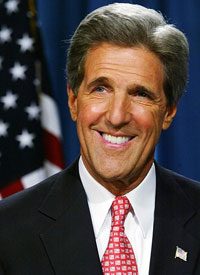
As the President and First Lady jaunt off to Copenhagen — on separate planes — to push for Chicago hosting the 2016 Olympics, Democrats in the U.S. Senate are trying to get ready for another meeting in Copenhagen: the UN Climate Change Conference in December. While the Obamas were working to maximize their “carbon footprint,” Senators Barbara Boxer and John Kerry were introducing legislation that is ostensibly aim at eliminating everyone else’s.
According to a Reuters story, “Climate control debate heats up in the Senate,”
The plan aims to cut carbon dioxide and other pollutants by encouraging broader use of solar, wind and other renewable fuels in place of dirtier ones such as oil. It also would invest U.S. funds in finding cleaner ways to burn coal and other fuels.
Written by liberal Senators Barbara Boxer and John Kerry, the proposal would achieve a 20 percent reduction in smokestack emissions by 2020 from 2005 levels. That is greater than the 17 percent cut set in a bill passed by the House of Representatives but less than what the European Union says it will achieve.
Obama applauded the bill, saying “we are one step closer to putting America in control of our energy future and making America more energy independent.”
It is not clear whether the full Senate will have time to debate and pass the bill before global climate change talks in Copenhagen in December.
While the environmental benefits of the proposals contained in the 800-page Boxer-Kerry bill are dubious, at best, the economic ramifications are nowhere near as subject to doubt: a substantial financial burden will hit every American home in the form of increased energy costs, and also an increase in the cost of goods and services because of the legislation. Among other expenses will be a new round of “sticker shock” at the gas station; again, according to the Reuters article: “American Petroleum Institute President Jack Gerard predicted the legislation would make gasoline prices shoot up to as much as $5 per gallon, about twice their current level.”
Even liberal Democrats cannot be counted on to back the radical Senate “cap-and-trade” bill; Sen. Jay Rockefeller (D-W.Va.) “called the proposal a step in the wrong direction with goals that are ‘unrealistic and harmful.’” Given the importance of coal to the economy of West Virginia, Rockefeller’s response is not that surprising: economic reality has a way of intruding itself time and again into the environmental debate. As the environmental facts are proving not to conform to the computer models developed by environmental extremists, the attempts to justify such radical measures such as the ones being proposed by Boxer and Kerry appear more and more disconnected from reality.
As the Copenhagen Conference draws nearer, the only “global warming” Americans can expect to witness will be in the wild rhetoric thrown around by the environmental fringe. Despite the efforts to delegitimize and silence critics of “climate change,” brave individuals such as EPA research analyst Alan Carlin and Czech President Vaclav Klaus are continuing to boldly draw attention to the disparity between environmentalist rhetoric and environmental fact. Happy thoughts about the future of alternative energy sources such as wind and solar power do not address the present economic realities of the American and global economy. The memory of the recent “cash for clunkers” debacle hasn’t faded away, yet — what did the economy or the environment really gain from throwing around billions of dollars in borrowed money so that Americans could buy vehicles for which they are already having a hard time keeping up the payments?
As the war against so-called “fossil fuels” continues, Americans should be asking, “Where are all of the non-gasoline cars going to come from, and who’s going to pay for them?,” and, “Who’s going to pay for the massive increase in my utilities bills every year as cheap coal and natural gas get forced out of the market?”
But then, we already know the answer to those questions, don’t we?



